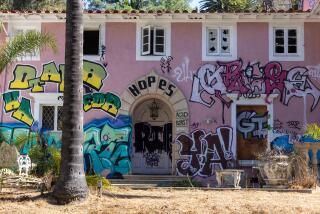Last House in Bunker Hill Razed
The last house in the Bunker Hill neighborhood of downtown Los Angeles has been leveled illegally by a developer whose upscale apartment projects have won praise for advancing downtown’s residential revival, city officials and preservationists said Tuesday.
The bedraggled wooden Queen Anne-style cottage -- razed on Saturday -- stood along West Cesar Chavez Avenue near Figueroa Street on the northern edge of Bunker Hill, a once-thriving residential area that was largely cleared out in the 1960s to make way for a cluster of skyscrapers.
The residence was built in 1887 and expanded to a two-story four-unit building in 1914. Los Angeles Building and Safety Department spokesman Bob Steinbach said the developer of the property, G.H. Palmer Associates, acted without either a city permit or a state-mandated environmental impact report.
“They have wanted this building down for quite some time,” said Ken Bernstein, preservation issues director for the Los Angeles Conservancy, the city’s leading preservation group. “We have not seen such a willful demolition of a historic home, completely without permits, in many years.”
Officials at Palmer’s offices would not comment Tuesday. The company’s recent projects include the 632-unit Medici apartment building, which opened downtown at 7th and Bixel streets in 2001, and the 297-unit Orsini Apartments at Cesar Chavez Avenue and Figueroa Street, where crews are at work now.
The company’s top official, Geoff Palmer, has locked horns previously with city officials over affordable housing mandates, which he argued were impractical.
“I’m just blown away,” said City Councilman Ed Reyes, who represents the area and had been involved in an effort to relocate the house. But before proposing a city response to the demolition, Reyes said, “I want to make sure I have all the facts.”
Bernstein and conservancy leaders are calling for city officials to punish the developer by blocking construction on the property for five years. Such a penalty is possible, Bernstein said, through a rarely invoked section of the city’s Municipal Code. The provision is known among preservationists as the “scorched earth” ordinance, Bernstein said, because it was adopted 13 years ago after the burning of a historic building on a coveted site.
The building department’s Steinbach said he was aware of the ordinance, but had “never heard of it being used. We don’t want to speculate on what might or might not happen.” In fact, he said, “We’re going to act as if the building is still there and ask [the developer] to get the clearances it should take to get the building demolished.”
If the developer can’t come up with those clearances, Steinbach said, “then we’ll decide what to do next.”
The city’s Community Redevelopment Agency has targeted that area for improvement, but officials said they were not aware of the demolition.
“We did not sign off on any demolition permit for the structure,” said spokeswoman Kiara Harris, “and we will be looking to city departments and the City Council to determine what the next step should be.”
Known as the Giese house for the family that lived there in its early years, the structure began its life as a relatively modest home in a part of the city known for its mansions. But after decades as one of the city’s most fashionable home addresses, Bunker Hill fell into disrepair and was largely scraped clean in the 1960s. In the course of the neighborhood’s transition, most homes were leveled and some were moved to the historic Angelino Heights and Heritage Square areas nearby.
But the Giese house remained at the area’s northern edge, near Chinatown. It is not listed among the city’s officially designated Historic-Cultural Monuments. Bernstein noted, however, that in 1982 the house was found eligible for the National Register of Historic Places by an architectural historian retained by the Community Redevelopment Agency.
The Giese house has cut a lonely profile in recent years, suffering dilapidation and repeated graffiti-scarring. On Dec. 17, the city’s Board of Building and Safety Commissioners declared the building a public nuisance, and staffers described it as “open to unauthorized entry and used repeatedly by vagrants, criminals, or gangs, or for other illegal purposes without the owner’s permission.”
“There were enforcement problems -- drugs, and apparently they found a few dead bodies there over the last year or so,” said Deputy City Atty. Michael Klekner. “It was a problem piece of property.”
But in recent months, city officials and preservationists had been more hopeful: A private buyer was arranging to purchase the structure and move it to Angelino Heights, and as recently as last Thursday, that buyer was meeting with the conservancy and officials from several city departments to lay plans for the move.
“Everybody was trying hard,” said Deputy City Atty. Curt Holguin, who was among those at a recent meeting. “We were making progress and then this happened.”
More to Read
Sign up for Essential California
The most important California stories and recommendations in your inbox every morning.
You may occasionally receive promotional content from the Los Angeles Times.











